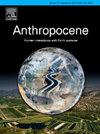Tracking the warning signal of extreme rainstorm and flood events in Haihe River Basin through historical documents
IF 3.3
2区 地球科学
Q2 ENVIRONMENTAL SCIENCES
引用次数: 0
Abstract
The available instrumental meteorological data spans less than a century, which is insufficient to robustly diagnose the mechanisms of extreme event occurrences. In this study, historical documents were used to identify extreme rainstorm-flood events in the Haihe River Basin (HRB) from 1736 to 1911, including their occurrence periods, affected areas, and rainfall characteristics. Moreover, early warning signals and climatic conditions associated with severe rainstorm-flood occurrences were disucssed. The findings indicate that, due to terrain uplift, the majority of severe floods in the HRB predominantly occurred in the piedmont plains of the Taihang Mountains. In particular, the landfall of long-distance typhoons along China’s southern coast, combined with the northward intensification of the western Pacific subtropical high, served as preconditions for these flood events. Accompanied by a significant increase in easterly and southeasterly winds, water vapor from the western Pacific Ocean and the South China Sea entered the North China Plain through double jet streams from the southeast and southwest. The majority of these floods occurred during La Niña years. Typhoon landfall, the strengthening of the northward movement of the western Pacific subtropical high, and La Niña events serve as key early warning signals for extreme rainfall and flooding, which are essential for disaster prevention and mitigation in the HRB.
通过历史文献追踪海河流域极端暴雨洪水事件预警信号
现有的仪器气象数据跨度不到一个世纪,不足以可靠地诊断极端事件发生的机制。本文利用历史资料,对1736 - 1911年海河流域极端暴雨洪水事件的发生时间、影响区域和降水特征进行了分析。此外,还讨论了与严重暴雨洪水有关的预警信号和气候条件。结果表明,由于地形抬升,青藏高原大部分严重洪涝灾害主要发生在太行山山前平原。特别是,中国南部沿海的长途台风登陆,加上西太平洋副热带高压向北增强,为这些洪水事件提供了先决条件。伴随着东风和东南风的显著增加,西太平洋和南海的水汽通过东南和西南双急流进入华北平原。这些洪水大多发生在La Niña年。台风登陆、西太平洋副热带高压北移加强和La Niña事件是极端降雨和洪水的重要预警信号,对南海防灾减灾至关重要。
本文章由计算机程序翻译,如有差异,请以英文原文为准。
求助全文
约1分钟内获得全文
求助全文
来源期刊

Anthropocene
Earth and Planetary Sciences-Earth and Planetary Sciences (miscellaneous)
CiteScore
6.30
自引率
0.00%
发文量
27
审稿时长
102 days
期刊介绍:
Anthropocene is an interdisciplinary journal that publishes peer-reviewed works addressing the nature, scale, and extent of interactions that people have with Earth processes and systems. The scope of the journal includes the significance of human activities in altering Earth’s landscapes, oceans, the atmosphere, cryosphere, and ecosystems over a range of time and space scales - from global phenomena over geologic eras to single isolated events - including the linkages, couplings, and feedbacks among physical, chemical, and biological components of Earth systems. The journal also addresses how such alterations can have profound effects on, and implications for, human society. As the scale and pace of human interactions with Earth systems have intensified in recent decades, understanding human-induced alterations in the past and present is critical to our ability to anticipate, mitigate, and adapt to changes in the future. The journal aims to provide a venue to focus research findings, discussions, and debates toward advancing predictive understanding of human interactions with Earth systems - one of the grand challenges of our time.
 求助内容:
求助内容: 应助结果提醒方式:
应助结果提醒方式:


